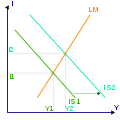Macroeconomics
Macroeconomics studies large-scale economic decisions. For example, a whole country's economy (or, its economic output) is summarised by the GDP (gross domestic product). Many governments use macroeconomic ideas to decide how much tax to collect and what interest rates should be.
It also considers the amount of unemployment, the rate that prices go up (inflation), and the exchange rates of its currency. The exchange rate affects the amount of imports and exports. Exchange rates and taxation are "levers of the economy".
Less dramatic, but also very important, are decisions about government spending inside the country. Such policy decisions are politically controversial due to differing political ideas on government spending. Another factor in macroeconomics is the make-up of the population. A growing population is economically different from a stable population (one which is not growing).
Macroeconomics Media
A chart using US data showing the relationship between economic growth and unemployment expressed by Okun's law. The relationship demonstrates cyclical unemployment. High short-run GDP growth leads to a lower unemployment rate.
John Maynard Keynes is considered the initiator of macroeconomics when he published his work The General Theory of Employment, Interest, and Money in 1936.
Sources
- Blanchard, Olivier 2011. Macroeconomics updated. 5th ed, Englewood Cliffs: Prentice Hall. ISBN 978-0-13-215986-9






